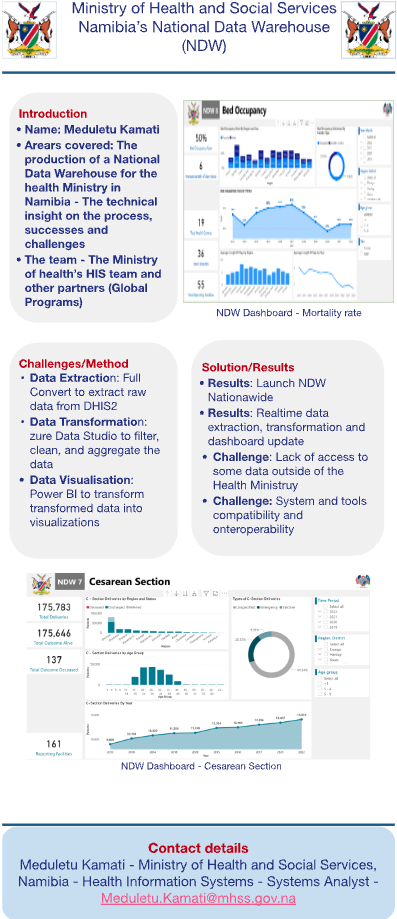Transforming Data into Insights - Namibia’s National Data Warehouse (NDW) Implementation with DHIS2
Data is one of the most valuable commodities we have at the moment. With this commodity, the utilization of DHIS2 for data management and analysis is one of the most critical implementations of making use of this commodity, especially in the public health sector.
A challenge exists in effectively leveraging the capabilities of DHIS2 and how they can integrate with other analytics tools while addressing evolving data needs and complexities. This abstract explores the depth of implementation for Namibia’s National Data Warehouse in which various tools have been integrated with DHIS2 to form complex analytics and dashboards. This project is empowered by the need for data that can drive decisions in the efforts of better health service provisions and resource management. Namibia has frequently encountered the constraints imposed by the DHIS2 analytics tools’ intrinsic complexities. Combined with a user interface lacking in many aspects, the need for visualization led to the exploration of other tools such as PowerBI.
Even though DHIS2 is still a vital and core tool for gathering and storing data for the country, as data volumes and complexity rise, so too may its applicability for sophisticated transformations and computations. As a result, the country explored alternative options in the efforts to run these complex data transformations and create a National Data Warehouse coupled with an easier interface to complement the data necessary for decision-making while enhancing accessibility and data ownership.
The first step in the process is to take Full Convert, a flexible data conversion application that enables smooth data transfer from several sources, and extract data from DHIS2. The main source of this raw data was DHIS2 and the primary health data capturing and storage system, although other national systems from different sectors such as population data were used.
From this data lake, this data was then transformed using Azure Data Studio. This was filtered data that spoke to the needs of the country’s NDW. The features of this tool can be used to clean, filter, and aggregate data to create an analytic solution that raw data could not provide. Using PowerBI, these facts of data are then transformed into visualizations that can be used as dashboards for NDW.
In conclusion, Namibian’s Health Ministry now has a strong platform for making data-driven decisions thanks to the combination of DHIS2, Power BI and other data transformation tools. The Ministry can now efficiently convert DHIS2 data into Power BI actionable insights by strategically utilizing technologies such as Full Convert, Azure Data Studio, and GitHub.
Through this link, Namibia will be able to fully utilize the richness of its data while also improving its analytical capabilities. NDW will therefore lead to well-informed decisions, the allocation of resources optimally, and the production of significant results in a healthcare provision, using this coordinated approach.
Primary Author: Meduletu Tangeni Kamati
Supporting Authors: Mr Erwin Nakafingo, Ms Anna Paulus, Mr Pinehas Johannes, Mr Appolinares Likoro, Mr Johannes Nakanyala, UCSF
Keywords: DHIS2, Power BI, data integration, data transformation, visualization, Full Convert, Azure Data Studio, GitHub, business intelligence.
